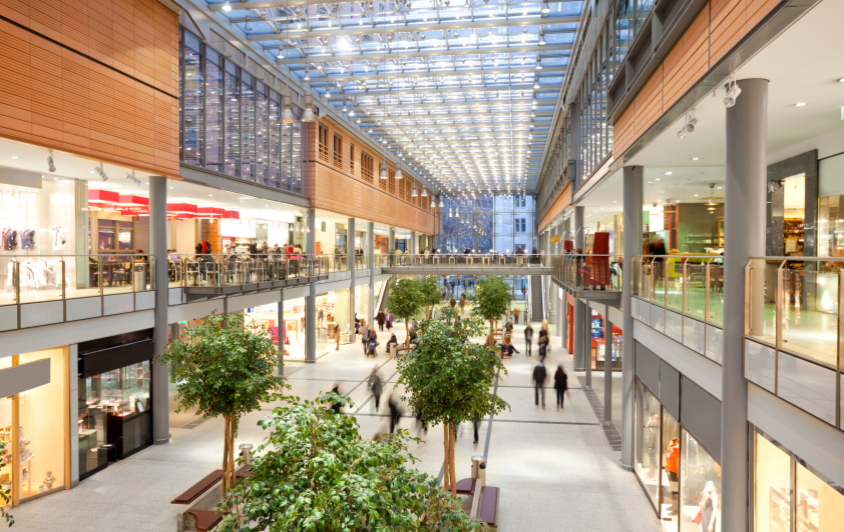The beginning of 2022 was an optimistic but uncertain period for retail destinations as the effects of Covid were not long behind us. Despite this, the excitement to return to a sense of normality saw the retail market begin to recover as shoppers roamed freely once more. As the year unfolded, consumers faced a series of unprecedented challenges. The outbreak of war and the subsequent cost-of-living crisis have impacted supply chains, economies, and businesses worldwide. However, despite ongoing pressures facing shoppers and shopping destinations, the future of retail remains bright. Take a look at this year’s most popular retail trends:
Everyone Is Talking About Technology
Today, more businesses realize the need for end-to-end digital business models. Technology is vital in building connected communities – whether that be your shoppers, your retail tenants, your local neighborhoods, or even your online communities. As the future of retail unfolds, consumers no longer shop to make a purchase. They shop to experience, discover, play, and connect. To meet rising consumer demands, businesses must invest in digital platforms to help them connect with their customers, build deeper relationships and increase customer engagement.
The world of retail is constantly evolving, and as a result, retail destinations must be able to grow as their customers do. New digital transformations and agile systems allow retailers to do just that – adapt quickly to changes in the market. The result is that retail destinations are more equipped to meet soaring customer expectations. For example, retail trends reflect consumer attitudes and behaviors, indicating a market pull. At the same time, retail technologies are designed to respond to these shifts, representing a market push. Together, this ‘push’ and ‘pull’ forces the market forward, driving change and innovation.
More than ever, consumers are demanding frictionless and often contactless experiences. Therefore, intelligent technologies delivering these features are critical to a successful retail strategy. Legacy technology systems cannot adapt nor respond fast enough to emerging retail trends. Digital technologies and platform-based solutions can help streamline business processes, reduce overall expenditure, boost efficiency and give consumers even more options – essentially, a digital platform delivers differentiation, which in turn, helps improve customer satisfaction.
New consumer behaviors are driving business innovation and transforming the retail sector, paving the way for more immersive online and in-store shopping experiences. The right digital platform should offer endless integration possibilities and open APIs, giving you the flexibility to integrate with emerging technologies and develop as the market does. Therefore, investing in a digital platform can help optimize your business performance and deliver seamless customer journeys. As digital innovation becomes more advanced, we expect to see this retail trend develop during 2023 as more businesses opt for more innovative technologies that can help them stay ahead of their competitors.
Omnichannel Opportunities
E-commerce was a lifeline for businesses during the pandemic and remains a core player for consumers, offering them ease, convenience, and flexibility. An online presence is essential for businesses wishing to succeed in today’s retail landscape. Whether offering customers buy now, pay later options, automating customer feedback, or curating personalized online experiences, E-commerce can help retailers create seamless customer journeys.
Nonetheless, the desire for brick-and-mortar shopping experiences has not diminished due to the pandemic; it has simply evolved. Consumers still want physical shopping experiences just as much as they once did, if not more! In fact, customers appreciate the tangibility of accessing products in person, with 34% saying they miss experiencing products before purchasing. That is why retailers are now taking steps to connect their online and offline territories as shopping destinations discover how they can best serve the omnichannel customer.
The online domain is not a replacement for physical retail but rather an enhancement of it, offering a way for customers to connect with the retail shops they know and love using their desired channels. Hybridizing retail benefits the customer and can provide retailers with better ways of collecting and managing data, offering additional data points and more engagement opportunities. Consumers demand seamless retail experiences alongside faster and more efficient services and deliveries. As a result, retail tenants now require access to data-driven technology to help them reinvent how shoppers interact in-store and online by creating personalized shopping experiences. As shopping destinations continue to diversify alongside their customers, omnichannel innovation is undoubtedly here to stay!
Delighting in Data
The pivot towards digital innovation in retail has seen data emerge as a crucial tool to predict and react to retail trends more effectively. Collecting, analyzing, and acting on customer data is imperative if retailers want to stay competitive in an ever-changing environment. Data insights are no longer a luxury in today’s retail market. They’re a lifeline.
Collecting rich data will not only give you a complete view of your customers, but it can also help you identify their needs and preferences too. Therefore, building out your data analytics capability will allow you to deliver greater personalization and omnichannel engagement and anticipate fluctuations in demand, giving you a deeper strategic advantage. As retail becomes progressively more ‘digital-first,’ your platform must be able to embed and capture data throughout the end-to-end customer journey seamlessly- but don’t worry, new digital technologies and smart platforms mean that it is easier than ever to collect customer data. To learn more, check out our article on Customer Data: Where to start.
However, simply collecting customer data is not enough. You must also know how to optimize it within your business. More and more retail destinations are realizing the need to dedicate time and resources to customer intelligence. This is because leveraging the data you collect enables you to create data-driven customer experiences. That way, you can optimize delivery across all of your channels and deliver precisely what your customers want, exactly when they need it. Whether that be personalized product recommendations, same-day delivery services, or even experiential product sampling. Start building your analytics capabilities and see what you can achieve with the right reporting tools.
Experiences are Essential
Today, consumers want differentiation and a reason to engage with your retail destination. Therefore, providing unique and memorable experiences across all of your retail channels is key to customer satisfaction. Gone are the days when blanket communications and standard retail experiences were acceptable. Research suggests that 73% of customers say their retail experience significantly impacts their purchasing decisions. That equates to almost three-quarters of your audience! Moreover, 86% of consumers say they would pay more for a great experience meaning that its imperative retail destinations turn their attention towards building great customer journeys.
A new way for retailers to enhance their customer experience is by incorporating game-like features into their customer journey. By imitating the engagement produced by games, brands can incentivize desired behaviors in their customers. Many retail giants have already begun introducing gamification. For example, Starbucks allows customers to collect ‘stars’ every time they purchase items in exchange for rewards. The benefit of this method is that customers become motivated to earn their next reward, and this impacts the frequency of their purchases.
Gamification is a great way to re-engage inactive customers, build brand loyalty and gain insight into your growing audience’s changing demographics and behaviors. You can also use gamification to help you compile even richer customer profiles, making it much easier to curate content that resonates with your audience. For example, by asking customers to heart their favorite brands or complete personalized questionnaires in exchange for trophies, tokens, or discounts. This way, you gain a deeper understanding of your customers and their preferences while simultaneously boosting their engagement with your brand.
The new age of social media, including the rise of platforms such as Tiktok, has changed how customers experience retail- particularly the younger generations. For example, unboxing videos have created a new way for customers to review products before purchasing. Similarly, affiliate marketing has become a popular way for Instagram influencers to promote and earn by sharing their favorite products. Many retailers are exploring ways of engaging customers through digital innovations due to ongoing retail competition. 73% of UK customers say they recently brought products as a result of social media influence. Therefore, channeling digitization throughout your retail strategy is critical to remaining relevant to a younger audience.
Today’s consumers increasingly prioritize experiences over material goods (particularly among millennials, where 75% say they value experiences over things). Additionally, as generation Z joins the workforce, the hunger for more immersive retail experiences is not to be underestimated. Your customers want hyper individualization- essentially, they want to feel special. As a result, they expect brands to connect with them on a personal level.
Not only this, but consumers today lack time, value convenience, and have more retail options than ever before, meaning customer loyalty is harder to maintain. Hence, the rise in contactless payments and services has transformed how customers experience retail. As a result, customer engagement solutions are becoming increasingly important for maintaining customer loyalty and helping deliver the seamless, individual experiences that shoppers expect.
Black Friday Results
November 2022 saw the arrival of a highly anticipated Black Friday weekend. As shoppers surged to make the most of Black Friday discounts and Cyber Monday sales, many retailers warned of a weak holiday turnout this year due to ongoing economic pressures. Statistics showed that inflation, which was up 7.7% as of October 2022, could thwart consumer spending, as predictions suggested that shoppers were tightening their belts to offset rising everyday bills.
However, despite global economic uncertainty, the US retail market saw a 2.3% increase in online sales compared with 2021, spending a record $9.12 billion, according to Adobe Analytics. Moreover, the UK saw a 9.3% increase in shopping behaviors across physical retail destinations compared with 2021. Physical footfall in retail destinations rose by 16.8%, with customers spending, on average, £17 more than they did in 2021.
According to Forbes, a prominent reason for these positive results is that shoppers could stretch their budgets due to the help of ‘buy now, pay later’ schemes that enabled consumers to access more deals. Black Friday predictions from Deloitte projected that there would be increased use of these services, with 48% of survey respondents saying they planned to use credit cards and 37% expecting to use buy now, pay later (BNPL) alternatives. And they were right, as orders made using these alternate methods rose by 78% the week of November 19-25th.
Coniq clients have also seen strong growth across several areas during this holiday period, seeing an impressive:
- 51.25% more loyalty transactions made during this year’s Black Friday weekend
- 34.97% more shoppers
- 50.29% more loyalty spend
It’s still early days for the 2022 holiday season, and it remains to be seen if consumers will continue shopping or if there will be a gradual decline in the lead-up to Christmas and New Year but so far, the good news is that the results from the Black Friday and Cyber Monday sales are promising.
This year’s retail sales seem to have curbed the cost-of-living concern and show encouraging signs that despite financial pressures, consumers still want to engage in shopping experiences. 2022 retail trends indicate that the market is on an upward trajectory and is set to make headways as we enter 2023, as the attention moves towards delivering differentiation, diversification, and digital innovation.
If retailers wish to stay ahead of the curve, they must continue developing their retail strategies to best serve the omnichannel customer. Investing in customer intelligence and immersive shopping experiences will help them deliver frictionless experiences, which will drive customer satisfaction, improve customer loyalty and increase their ROI.






